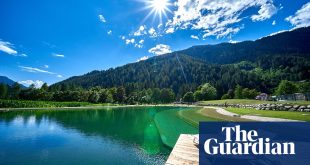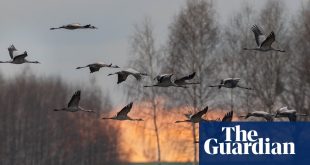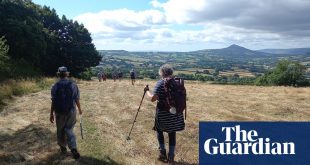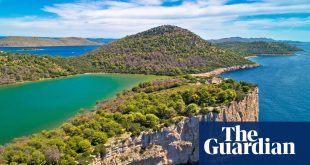The morning had the bright clarity of perfect light, framing the landscape in stark relief against a clear blue sky. It was too perfect, one of those mornings that would soon be lost to rain. But as I looked out from the granite cliffs of Land’s End, I could see stark shapes interrupting the horizon between sea and sky. That was the first time I saw the Isles of Scilly, tiny black specks in the Celtic Sea, at the vast blue edge of the Atlantic Ocean. They disappeared into the rain of the day and I never saw them again. Not until today.
It has been 10 years since we walked the South West Coast Path. Ten years since that first sighting of Scilly, but it’s only now that we are finally leaving Land’s End, watching that familiar coastline grow smaller – me and my husband – heading to an unknown land and unwalked paths. But as we step on to St Mary’s, I begin to understand these islands aren’t so unfamiliar. The blocky granite stacks along the coastline of Scilly’s largest island echo those that surround the western tip of Cornwall. This outcrop of islands might be separated from the mainland by 28 miles of sea, but it’s firmly connected by granite.
We’re here for Walk Scilly, a week of guided walking tours of the archipelago, although our tour will be self-led.
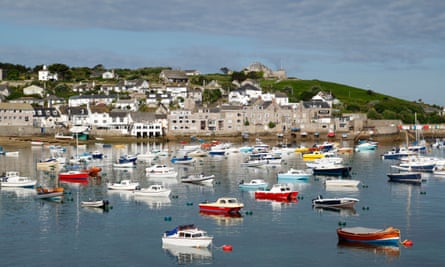
Grabbing pasties for later from Hugh Street Cafe, where everything is made from scratch, we drop our bags at Tregarthen’s Hotel and moments later are on a boat crossing crystal blue sea to the northernmost island of St Martin’s. Within minutes of stepping on to the island the other passengers have disappeared down tiny lanes that lead from the quay, but we’re transfixed by the immediate sense of otherness. These islands might share the same geology, ever-present wind and salt air as the mainland, but the vegetation is of another world – succulents, palms and Allium triquetrum grow from every crevice, giving it a Mediterranean feel.
A narrow lane leads through a scattering of houses, where the only vehicle is an electric trike. We seem to have slipped into another time – older, simpler; even the wind has dropped to a softer warmth. But we’re drawn to a path leading to the northern side of the island and a totally different landscape of jagged rocks falling to an empty white beach, with gannets diving into a turquoise sea. And everywhere gorse is in full flower, covered in bees, carpeting the island in gold and filling the air with the rich smell of coconut.
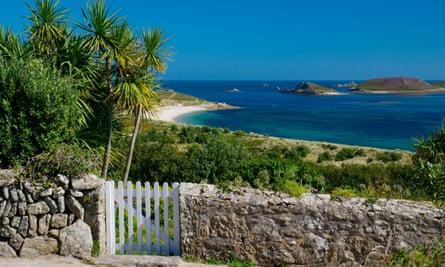
With our backs to the warm stone of the red and white striped daymark on the headland, we eat our pasties, lost in the wonder of the view. But time is pressing and the last ferry can’t be missed, so we hurry down easy paths along the eastern edge of the island, through tiny fields protected from the winds by high pittosporum hedges and filled with wildflowers, vegetables and potatoes.
A lot of food is grown here (although most supplies come from the mainland), creating a need for self-reliance, and also for good neighbours. Along the sand road behind the dunes to St Martin’s Vineyard and Winery, we could have stayed to sample the wine or visit the little independent shops that line the one street on St Martin’s, but we’re too late: everywhere has closed. We’ve spent too long on the wild side.
Back on St Mary’s, we stop for tapas at Dibble and Grub, overlooking Porthcressa beach as the sun goes down – and I wonder if the patatas could taste any better, or the view be more special, if we were actually in the Mediterranean.
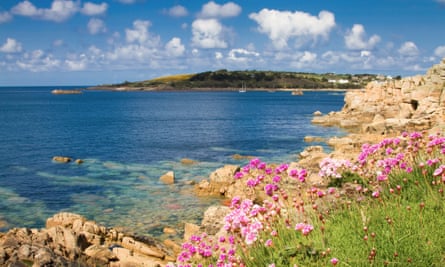
The following morning takes a slower pace, enjoying the breathtaking view from Tregarthen’s towards the islands of Tresco, Bryher and Samson, and talking to the hotel staff who all, homegrown or incomers, hold a passion and knowledge for these islands. Beyond a collection of small shops we find a path heading to the north of St Mary’s, past racks of gig boats lined up waiting for the world pilot gig championships the coming weekend.
Then over the white sands of Town beach and Porthloo, on to a narrow path between gorse and bramble to Halangy Down and the ruined prehistoric village. Each of these islands has a spectacular circular walk, their very own coastal path, and I’m drawn to keep going, to stay on this path and explore the east of the island, but we’re attending an author talk in Hugh Town so retrace our steps, still finding time to divert into Juliet’s Garden and drink tea in a restaurant garden with a view like no other.

It’s evening when we walk up to the Garrison – built to fend off the Spanish in the 16th century – with a viewpoint that takes in the whole archipelago. As the sun slips below the horizon the sky is lit into a deep, rich red and orange, and I’m lost in the magic of these islands.
after newsletter promotion
Early morning and we’re on the Tresco ferry, heading to an island famous for its garden. But that’s not the reason for the early start. We’re here on one of the few low-tide days of the year, when the sandbar between Tresco and Bryher is fully exposed and it’s possible to walk between the two islands. Islanders and tourists are out to celebrate, turning the sandbar into a party at 11am, where people are dancing to the sound of a kazoo, drinking local gin and eating paella from Island Fish.
We share in the madness of the morning with a 90-year-old who comes every year from the east of England, just for this moment, and a woman who leaves mainland life behind to spend the summer here. Crossing on to Bryher’s calm eastern shoreline – where boats line the sand, a 4×4 collects boxes from the quay and the party goes on – there’s a sense of the bustle of St Mary’s. As we leave the activity behind and head to the west of the island, the wind rises and even on this quiet day the powerful Atlantic rolls on to the rocky headland.
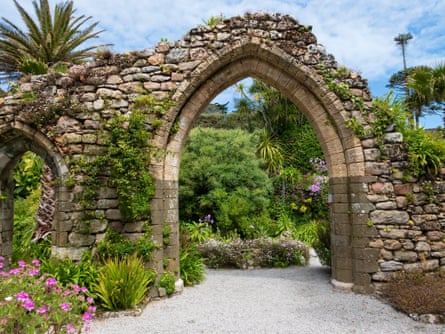
I can see that when the party leaves the sandbank, Bryher will return to being a place that belongs to the seals and oystercatchers. But there’s no hanging around: we race back over the sandbar before we’re cut off by the tide and head to Tresco Abbey Gardens. I’m overwhelmed by plants that are treated as tender on the mainland, but here grow from the walls as self-seeded triffids, thriving in this microclimate.
I could spend days in this garden and it wouldn’t be enough, but yet again we’re chasing tides. Back at Tregarthen’s, the Tanglewood Kitchen Company has delivered the freshest possible lobster salad takeaway. We eat it on the beach, among the cormorants and oystercatchers, under a final perfect sunset.
One last morning on the south of St Mary’s, regretting not having time to visit St Agnes, and our trip is over. We’re away on the Scillonian ferry. There are miles of paths on these islands and we’ve only walked a few, but I’m hooked and I know I’ll soon be booking my return trip. As the stretch of sea between us and the islands grows wider, I can see how distance has made the islanders self-reliant. But they’ve shown me it’s possible to be individual and independent, yet interdependent at the same time – we could all learn a lot from that.
The trip was provided by visitislesofscilly.com. Tregarthen’s Hotel on St Mary’s has double rooms from £130. The Scillonian ferry sails from Penzance to St Mary’s (2¾ hours, adults from £76.25)
Raynor Winn is the author of Landlines (Penguin, £10.99). To support the Guardian and Observer order your copy at guardianbookshop.com for £9.34
 Top Naija News: Nigerian News, Breaking News Nigeria and World News Top Naija News is a daily news publication in Nigeria, delivering the latest breaking news in Nigeria and around the world.
Top Naija News: Nigerian News, Breaking News Nigeria and World News Top Naija News is a daily news publication in Nigeria, delivering the latest breaking news in Nigeria and around the world.
